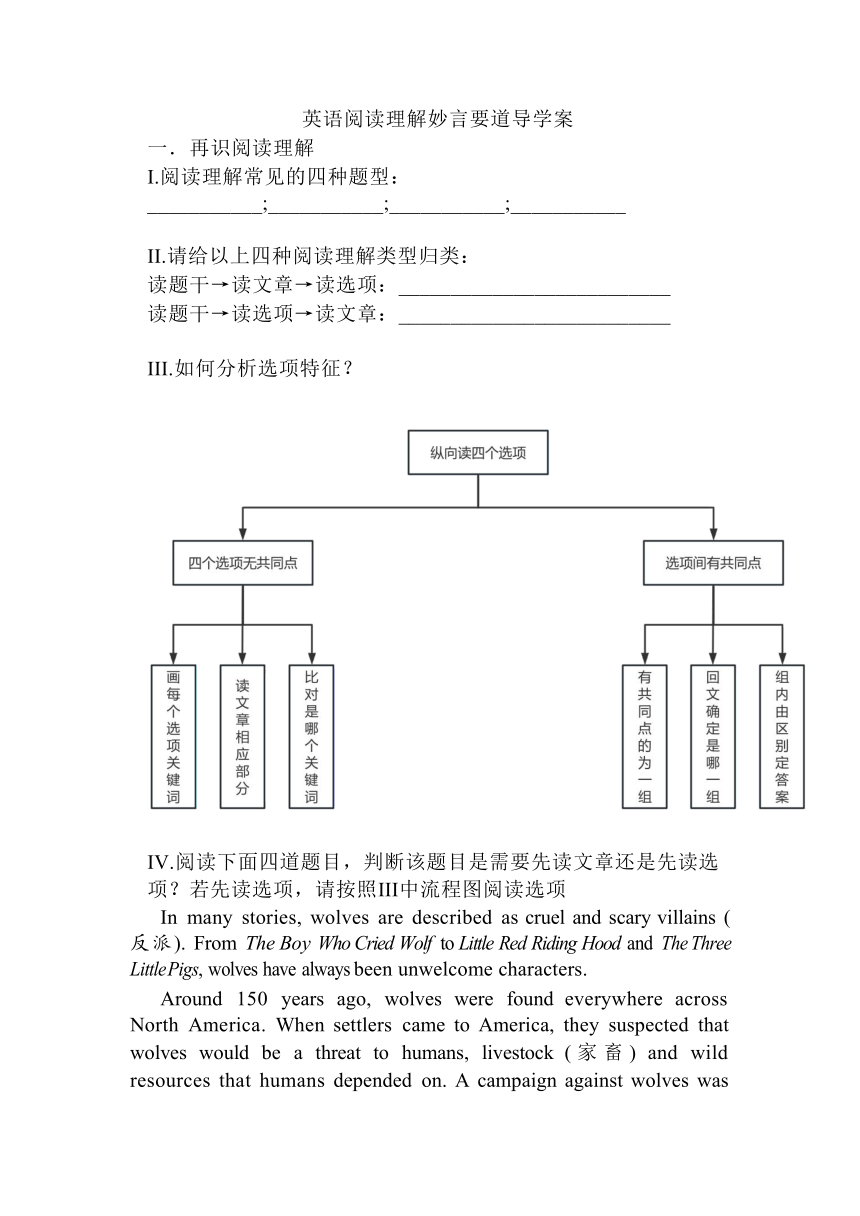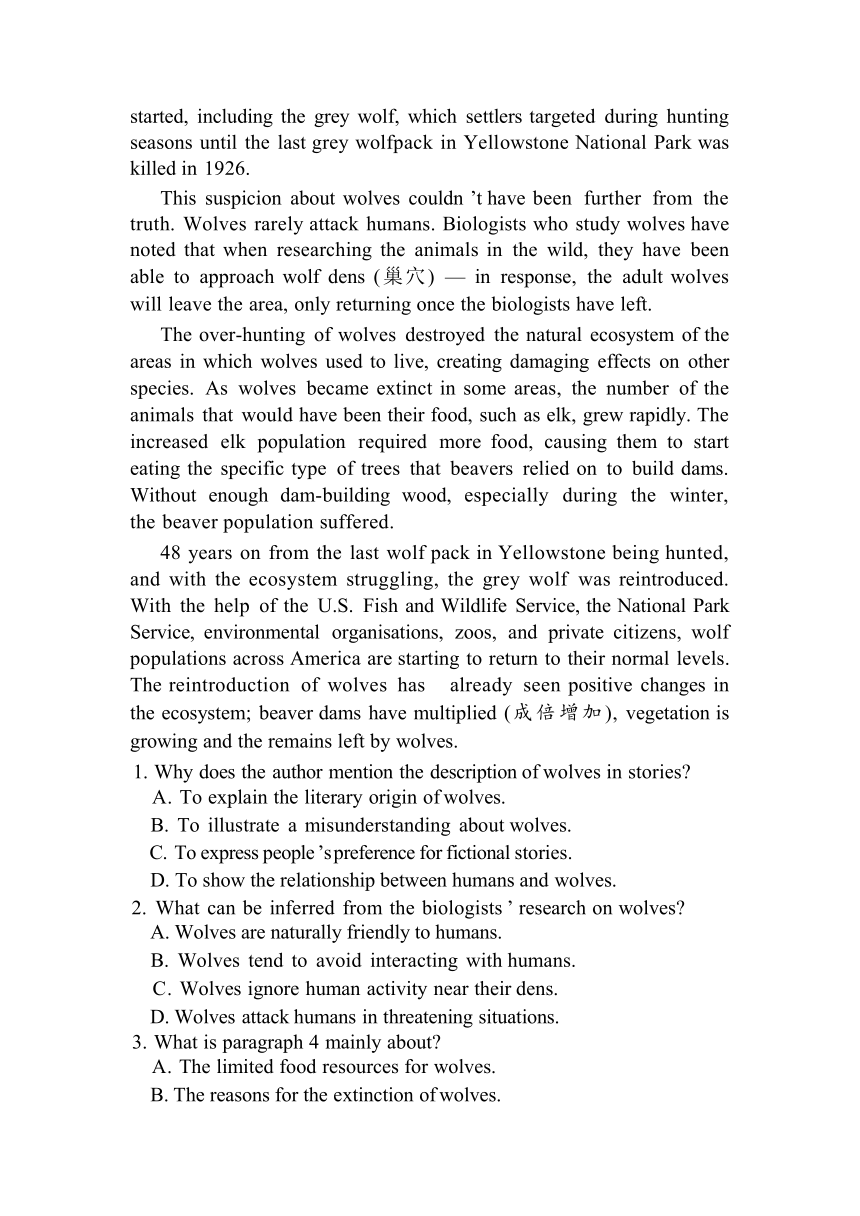英语阅读理解妙言要道导学案(无答案)-2025届高三英语复习
文档属性
| 名称 | 英语阅读理解妙言要道导学案(无答案)-2025届高三英语复习 |  | |
| 格式 | docx | ||
| 文件大小 | 121.6KB | ||
| 资源类型 | 教案 | ||
| 版本资源 | 人教版(2019) | ||
| 科目 | 英语 | ||
| 更新时间 | 2025-02-05 14:12:30 | ||
图片预览


文档简介
英语阅读理解妙言要道导学案
再识阅读理解
I.阅读理解常见的四种题型:___________;___________;___________;___________
II.请给以上四种阅读理解类型归类:
读题干→读文章→读选项:__________________________
读题干→读选项→读文章:__________________________
III.如何分析选项特征?
IV.阅读下面四道题目,判断该题目是需要先读文章还是先读选项?若先读选项,请按照III中流程图阅读选项
In many stories, wolves are described as cruel and scary villains (反派). From The Boy Who Cried Wolf to Little Red Riding Hood and The Three Little Pigs, wolves have always been unwelcome characters.
Around 150 years ago, wolves were found everywhere across North America. When settlers came to America, they suspected that wolves would be a threat to humans, livestock (家畜) and wild resources that humans depended on. A campaign against wolves was started, including the grey wolf, which settlers targeted during hunting seasons until the last grey wolfpack in Yellowstone National Park was killed in 1926.
This suspicion about wolves couldn ’t have been further from the truth. Wolves rarely attack humans. Biologists who study wolves have noted that when researching the animals in the wild, they have been able to approach wolf dens (巢穴) — in response, the adult wolves will leave the area, only returning once the biologists have left.
The over-hunting of wolves destroyed the natural ecosystem of the areas in which wolves used to live, creating damaging effects on other species. As wolves became extinct in some areas, the number of the animals that would have been their food, such as elk, grew rapidly. The increased elk population required more food, causing them to start eating the specific type of trees that beavers relied on to build dams. Without enough dam-building wood, especially during the winter, the beaver population suffered.
48 years on from the last wolf pack in Yellowstone being hunted, and with the ecosystem struggling, the grey wolf was reintroduced. With the help of the U.S. Fish and Wildlife Service, the National Park Service, environmental organisations, zoos, and private citizens, wolf populations across America are starting to return to their normal levels. The reintroduction of wolves has already seen positive changes in the ecosystem; beaver dams have multiplied (成倍增加), vegetation is growing and the remains left by wolves.
1. Why does the author mention the description of wolves in stories
A. To explain the literary origin of wolves.
B. To illustrate a misunderstanding about wolves.
C. To express people ’s preference for fictional stories.
D. To show the relationship between humans and wolves.
2. What can be inferred from the biologists ’ research on wolves
A. Wolves are naturally friendly to humans.
B. Wolves tend to avoid interacting with humans.
C. Wolves ignore human activity near their dens.
D. Wolves attack humans in threatening situations.
3. What is paragraph 4 mainly about
A. The limited food resources for wolves.
B. The reasons for the extinction of wolves.
C. The biological impacts of wolf extinction.
D. The studies on the living habits of wolves.
4. What is a direct result of the reintroduction of the grey wolves
A. The ecosystem shows a sign of recovery.
B. Smaller animals in the wild decrease in number.
C. Humans realise wildlife ’s struggle for survival.
D. Environmental organisations cooperate more closely.
V.文章设题位置
分析并完成以下练习
练习2(2024年全国甲卷C)
The Saint Lukas train doesn’t accept passengers — it accepts only the sick. The Saint Lukas is one of five government-sponsored medical trains that travel to remote towns in central and eastern Russia. Each stop lasts an average of two days, and during that time the doctors and nurses on board provide rural (乡村) populations with basic medical care, X-ray scans and prescriptions.
“People started queuing to make an appointment early in the morning.” says Emile Ducke, a German photographer who traveled with the staff of the Saint Lukas for a two-week trip in November through the vast regions (区城) of Krasnoyarsk and Khakassia.
Russia’s public health care service has been in serious need of modernization. The government has struggled to come up with measures to address the problem, particularly in the poorer, rural areas east of the Volga River, including arranging doctor’s appointments by video chat and expanding financial aid programs to motivate doctors to practice medicine in remote parts of the country like Krasnoyarsk.
The annual arrival of the Saint Lukas is another attempt to improve the situation. For 10 months every year, the train stops at about eight stations over two weeks, before returning to the regional capital to refuel and restock (补给). Then it starts all over again the next month. Most stations wait about a year between visits.
Doctors see up to 150 patients every day. The train’s equipment allows for basic checkups. “I was very impressed by the doctors and their assistants working and living in such little space but still staying focused and very concerned,” says Ducke. “They were the best chance for many rural people to get the treatment they want.”
1. How is the Saint Lukas different from other trains
A. It runs across countries.
B. It reserves seats for the seniors.
C. It functions as a hospital.
D. It travels along a river.
2. What can we infer from paragraph 3 about Krasnoyarsk
A. It is heavily populated.
B. It offers training for doctors.
C. It is a modern city.
D. It needs medical aid.
3. How long can the Saint Lukas work with one supply
A. About a year.
B. About ten months.
C. About two months.
D. About two weeks.
4. What is Ducke’s attitude toward the Saint Lukas’ services
A. Appreciative.
B. Doubtful.
C. Ambiguous.
D. Cautious.
再识阅读理解
I.阅读理解常见的四种题型:___________;___________;___________;___________
II.请给以上四种阅读理解类型归类:
读题干→读文章→读选项:__________________________
读题干→读选项→读文章:__________________________
III.如何分析选项特征?
IV.阅读下面四道题目,判断该题目是需要先读文章还是先读选项?若先读选项,请按照III中流程图阅读选项
In many stories, wolves are described as cruel and scary villains (反派). From The Boy Who Cried Wolf to Little Red Riding Hood and The Three Little Pigs, wolves have always been unwelcome characters.
Around 150 years ago, wolves were found everywhere across North America. When settlers came to America, they suspected that wolves would be a threat to humans, livestock (家畜) and wild resources that humans depended on. A campaign against wolves was started, including the grey wolf, which settlers targeted during hunting seasons until the last grey wolfpack in Yellowstone National Park was killed in 1926.
This suspicion about wolves couldn ’t have been further from the truth. Wolves rarely attack humans. Biologists who study wolves have noted that when researching the animals in the wild, they have been able to approach wolf dens (巢穴) — in response, the adult wolves will leave the area, only returning once the biologists have left.
The over-hunting of wolves destroyed the natural ecosystem of the areas in which wolves used to live, creating damaging effects on other species. As wolves became extinct in some areas, the number of the animals that would have been their food, such as elk, grew rapidly. The increased elk population required more food, causing them to start eating the specific type of trees that beavers relied on to build dams. Without enough dam-building wood, especially during the winter, the beaver population suffered.
48 years on from the last wolf pack in Yellowstone being hunted, and with the ecosystem struggling, the grey wolf was reintroduced. With the help of the U.S. Fish and Wildlife Service, the National Park Service, environmental organisations, zoos, and private citizens, wolf populations across America are starting to return to their normal levels. The reintroduction of wolves has already seen positive changes in the ecosystem; beaver dams have multiplied (成倍增加), vegetation is growing and the remains left by wolves.
1. Why does the author mention the description of wolves in stories
A. To explain the literary origin of wolves.
B. To illustrate a misunderstanding about wolves.
C. To express people ’s preference for fictional stories.
D. To show the relationship between humans and wolves.
2. What can be inferred from the biologists ’ research on wolves
A. Wolves are naturally friendly to humans.
B. Wolves tend to avoid interacting with humans.
C. Wolves ignore human activity near their dens.
D. Wolves attack humans in threatening situations.
3. What is paragraph 4 mainly about
A. The limited food resources for wolves.
B. The reasons for the extinction of wolves.
C. The biological impacts of wolf extinction.
D. The studies on the living habits of wolves.
4. What is a direct result of the reintroduction of the grey wolves
A. The ecosystem shows a sign of recovery.
B. Smaller animals in the wild decrease in number.
C. Humans realise wildlife ’s struggle for survival.
D. Environmental organisations cooperate more closely.
V.文章设题位置
分析并完成以下练习
练习2(2024年全国甲卷C)
The Saint Lukas train doesn’t accept passengers — it accepts only the sick. The Saint Lukas is one of five government-sponsored medical trains that travel to remote towns in central and eastern Russia. Each stop lasts an average of two days, and during that time the doctors and nurses on board provide rural (乡村) populations with basic medical care, X-ray scans and prescriptions.
“People started queuing to make an appointment early in the morning.” says Emile Ducke, a German photographer who traveled with the staff of the Saint Lukas for a two-week trip in November through the vast regions (区城) of Krasnoyarsk and Khakassia.
Russia’s public health care service has been in serious need of modernization. The government has struggled to come up with measures to address the problem, particularly in the poorer, rural areas east of the Volga River, including arranging doctor’s appointments by video chat and expanding financial aid programs to motivate doctors to practice medicine in remote parts of the country like Krasnoyarsk.
The annual arrival of the Saint Lukas is another attempt to improve the situation. For 10 months every year, the train stops at about eight stations over two weeks, before returning to the regional capital to refuel and restock (补给). Then it starts all over again the next month. Most stations wait about a year between visits.
Doctors see up to 150 patients every day. The train’s equipment allows for basic checkups. “I was very impressed by the doctors and their assistants working and living in such little space but still staying focused and very concerned,” says Ducke. “They were the best chance for many rural people to get the treatment they want.”
1. How is the Saint Lukas different from other trains
A. It runs across countries.
B. It reserves seats for the seniors.
C. It functions as a hospital.
D. It travels along a river.
2. What can we infer from paragraph 3 about Krasnoyarsk
A. It is heavily populated.
B. It offers training for doctors.
C. It is a modern city.
D. It needs medical aid.
3. How long can the Saint Lukas work with one supply
A. About a year.
B. About ten months.
C. About two months.
D. About two weeks.
4. What is Ducke’s attitude toward the Saint Lukas’ services
A. Appreciative.
B. Doubtful.
C. Ambiguous.
D. Cautious.
